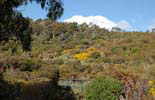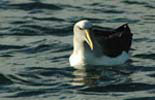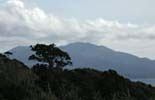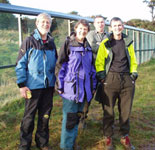 |
 |
 |
 |
||
 |
||
 |
||
 |
||
| Visitors to the Dancing Star Foundation Ecological Fence. New Zealand Prime Minister Helen Clark with her husband, Peter Davis (far left), Dept. of Conservation Biodiversity Programme Manager, Andy Roberts (rear) and DOC Southland Conservator, Kevin O’Connor. Photo: © Brent Beaven |
||
In New Zealand, Dancing Star Foundation owned and maintained an ecological preserve which the Foundation created on the southern most island of Rakiura, or Stewart Island.
Comprising over 400 acres of hilly coastal land adjoining New Zealand's most recently designated Rakiura National Park, the DSF Preserve can be divided into four distinct floral zones: Podocarp-broadleaf forest, coastal vegetation with an array of Coprosma, tree ferns and tree fuchsia, a small sphagnum-and-sedge wetland and pasture with sedges, bracken and various grasses. The forest is dominated by kamahi (Weimannia racemosa), rata (Metrosideros umbellate), rimu and miro trees. The coniferous rimu (Dacrydium cupressinum) may live in excess of 500 years and grow to forty metres. The Preserve contains at least 126 native species, at least 11 native bird species and 7 known invertebrate species.
Among the many bird species found in the Preserve are Red-crowned Parakeets (Kakariki, Cyanoramphus novaezelandiae), Wood Pigeon (Kukupa or Keruru, Hemiphaga novaeseelandiae ), parrots (Kaka, Nestor m.meridionalis), Tomtit (Ngiru-ngiru, Petroica macrocephala), Fantail (Piwakawaka, Rhipidura f. fulginosa), Bellbird (Korimako, Melanura anthornis), Tui (Prosthemadera novaeseelandiae), Grey Warbler (Riroriro, Gerygone igata), Silvereye (Tauhou, Zosterops lateralis lateralis) and Blue Penguins (Korora, Eudyptula minor).
The formaer DSF Preserve constitutes what conservationists call a "mainland island." A large portion of the refuge has been specially enclosed within an approximately 2.1 kilometer long state-of-the-art ecologically-engineered fence (designed by the internationally-famed New Zealand-based company, Xcluder) to help inhibit the movement into the sanctuary of non-native mammals which have a serious, negative impact upon indigenous life forms. An extensive grid of protections is in place, including electronic and video surveillance, with instant telephonic and satellite communication to a national network and a response team that can counteract any and all breaches.
Along with Ulva Island, the DSF Preserve was the only predator free piece of land on all of Stewart Island/Rakiura, and the first true place of safety for native species in 150 years on the Stewart Island mainland, New Zealand’s third largest island.
Other community and Department of Conservation efforts on the island indicate that, in time, the entirety of Stewart Island may well be free of non-native predators, making it one of the most globally important islands of biodiversity in the world.
And it is a vision that is, at least symbolically, a metaphor and true microcosm for the kind of research and goals embraced by DSF throughout the world.
.

